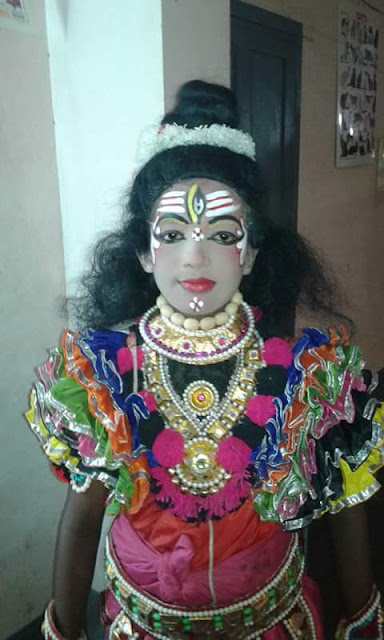Traditional
Jewellary of Tulunadu
At the time of wedding as well as
numerous other occasions, a Bunt woman is gifted jewelry by her parents and
relatives. Jewellery is considered as status symbol. The traditional jewelery
of Tulunadu is what makes the Bunt weddings so rich and unique their own
manner. The different jewellary includes armlets, bracelets, bangles,
necklaces, earnings, fingerings, nose rings etc. Tulunadu follow their unique designs and they
have unique names too. Such as,
vadungeela( i.e., the ring that
the groom slips into the bride’s finger), Panchaungila( A five ring connected
gold jewellery for all the fingers in hand) Kadaga( Thick bangle), Vanki(Armlet,
an upper arm ornament), Thang( Support for earnings and is made of gold or
pearls and is hooked to the earnings and then attached to the hair above the
ear), Kanti Sara( Necklace), Talisman- Urku ( a charm worm by toddlers and
young children to avert evil and bring good fortune ), Vonti (Small studs worm
by men), etc, These are the traditional jewelary in Tulunadu.
As
in other parts of India, the local jewellery is similar to the ones that are
traditional to the native Udupi district and the neighbouring Dakshina Kannada,
Uttara Kannada, Shimoga and Chikmagalur districts. Woman either inherits or
receives jewelry at the time of wedding and other important occasions. Jewelry
is a status symbol and most of the families hold jewelry as passed on for
generations. There are varieties of jewelries depending on which part of the
body it is worn, namely necklace, earrings, finger rings, toe rings, nose
rings, bracelets, armlets, pendants, waistbands. The stone-encrusted jewellery
is quite common. The local people still have a strong belief in the efficacy of
the navaratnas (nine gems) in warding off evil and enhancing the beneficial
effects of planets. The Navaratnas find its common use in women’s jewellery too
other than the rings worn by the men.
Ear
Ornaments: Kempu Bendole, the Kempu ear-stud made of red stones such as ruby is
unique to this region. These are worn on ears. Jimki (eardrop) is more of a
modern phenomenon of this region. Jimki is a bell-shaped ear jewel set in
coloured stones with pearls hanging at the lower end. Traditional ear wear has
evolved from the Karna Kundala type, the Koppu, to Vajrada Bendole, the Kudkan
Jodi, which are made of natural or manmade Diamonds. Wearing Bugudis on the
upper ear lobes is almost extinct due to the heavy weight of the jewel. Bugudis
are usually supported by the Kenne Sarapali and is hooked on to the hair to
take the weight of the ornament. There is yet another type, the Lavangada
Kaddi, a clove shaped ornament is worn by the class that can't afford the
Bugudi. As these are of thicker stems, ear-holes are to be too broad and hence are
hardly seen nowadays.
Neck
jewellery is a world apart and the variety is endless. The traditional Gejje
adigai has almost become an extinct due to the complexity in workmanship needed
to make the necklace. Gejje Adigai is a thick herringbone band of necklace on
which round bells are fixed at the bottom. The necklace of mangoes, the
Kukkumudi Sara, consists of either stone-studded or the gold mangoes strung
together. Pavan sara or Misri Male, the gold coin chain, consists of coins or
tokens with religious figures held together or hung on the gold chain. Other
jewellery includes Sarapali, the chain, Kanti, the necklace made of pearls or
Coral. Chakra saras are the chains that consisted of three strings formed with
golden discs or chakras. Malligemuggu Sara, the Jasmine bud necklace, the Godhi
Sara that has tiny golden wheat grains, Gundu sara which is made of round beeds
and Navarathna sara consisting of nine precious gems are the other popular
necklaces.
The
basic jewel for a married woman is the Thaali or Mangalasuthra, the Kariyamani.
First tied on string and then replaced by a gold chain, the important part of
the Thaali is the Pendant or Padaka, whose design is determined by the
community to which the woman belongs.
The
feet are adorned with Gejje (silver anklet). Oddiyaana, the gold waist belt
adorns the waist. Vanki (armlet) are worn on certain occasions such as wedding,
anniversary and other rituals. Hair ornament with hair pin is attached to the
top of the braid or in buns to hold them in place is known as Tareta poo.
Kedage, Sampige etc. are the flower patterns often seen in these pin heads.
Nagara is the earlier version of Bun wear where Gopalakrishna playing flute
with Serpent as umbrella is the main theme of art. Nagara has Beads in three or
four rows surrounding the above theme.
For
nose, Mooguthi, Moonkuda bottu and Natthu are the three known main varieties.
The elderly women of older generation mostly wore Mooguthi, the nose-stud that
is studded with diamond. The Natthu, the dangling nose stud was mostly worn by
the younger population. It is common to see the gold tinsel on the nose,
nowadays. Toe ring has the simplest design of all. Finger rings when worn on
five fingers are known as Panchungila and the one that is gifted to the groom
is known Vadungila. The rich brides braid is often decorated with a long Nagara
plait that is studded ith gems.
 The
children wear Sonta-da-noolu and the coral chain that has a golden Pepal leaf
Padaka. With the rising gold price, the old jewelries have seen the molten pot
and the new hollow, light weight jewelries are getting more popular.These
all about Our Tulunadu traditional jewellary.
The
children wear Sonta-da-noolu and the coral chain that has a golden Pepal leaf
Padaka. With the rising gold price, the old jewelries have seen the molten pot
and the new hollow, light weight jewelries are getting more popular.These
all about Our Tulunadu traditional jewellary.




